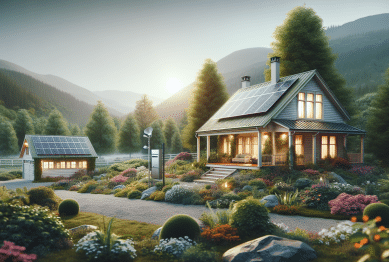Explore practical and inspiring ways you can bring sustainable gardening right to your doorstep. This guide examines eco-friendly landscaping strategies, water-saving tips, organic practices, and natural solutions for a vibrant home garden that supports your well-being and the planet.
Understanding Sustainable Gardening At Home
Sustainable gardening at home goes beyond simple plant care. It uses thoughtful methods to foster growth while protecting natural resources, supporting the local ecosystem, and reducing waste. Many homeowners are turning to eco-friendly gardening techniques to foster biodiversity, enrich their soil, and create a green haven for pollinators and pets. At its core, sustainable gardening means nurturing your outdoor space using smart watering, composting, and plant choices that thrive in your environment. Every decision in your garden—from soil improvement to pest management—can make a significant impact when you focus on sustainability. People value this approach not just for aesthetics but also as a way to create a regenerative cycle, where garden waste becomes nourishment for new growth and fewer chemicals reach the broader ecosystem.
Gardening practices that care for the planet also save money and time. For example, designing a native plant garden can reduce the need for supplemental watering and fertilizers. By choosing flora adapted to local weather and soil, gardeners can lower maintenance needs and attract helpful wildlife like bees and birds. These plants are more resistant to regional pests and diseases, making the garden less dependent on synthetic treatments. This change, even in small spaces or container gardens, brings substantial benefits for air quality and neighborhood aesthetics. With planning, a home garden can become a lush, low-impact sanctuary that grows alongside your family.
One of the first steps toward greener gardening involves understanding your local climate and soil profile. Resources from extension services and horticultural societies help homeowners test their soil and choose plants that thrive naturally. Integrating mulch, compost, and rain barrels can further enhance your garden’s resilience. Composting kitchen scraps transforms household waste into a soil booster, cutting landfill contributions and enriching the garden bed. When you commit to sustainable gardening at home, you set a valuable example for your community, helping to shift practices across neighborhoods and sparking wider environmental change.
Eco-Friendly Landscape Design Essentials
Eco-friendly landscape design prioritizes minimal disruption to nature while beautifying your outdoor space. Imagine a yard where every corner supports local wildlife, draws less on resources, and offers relaxation. Start by analyzing your yard’s sunlight, drainage, and existing plant life. Using native or drought-tolerant plants forms the backbone of most sustainable designs. Grouping plants that share water needs reduces excess watering and encourages deep roots. Adding elements such as permeable pavements, rain gardens, and bioswales helps manage stormwater naturally. Strategic plant placement means a cooler home in summer and less watering year-round—resulting in lower utility bills and a richer habitat for birds and insects.
Simple swaps can also make a big difference. Replacing turf grass with ground covers, clover, or ornamental grasses saves time and fossil fuel usage by reducing mowing. Incorporating shrubs and trees that flower or bear fruit will support pollinators and provide seasonal interest. If privacy is essential, hedges of native shrubs are a beautiful alternative to fences, blending functionality with ecological benefits. Creating multi-layered beds with trees, shrubs, and perennials mimics natural habitats and increases resilience against weather events. Mulching beds with leaves or wood chips prevents water loss and blocks weeds while gradually improving soil health. This curbs the need for chemical weed killers and keeps the landscape vibrant all season.
Integrating pathways and seating invites people to linger in the garden, forging a deeper connection with nature. Materials like reclaimed wood, natural stone, or recycled bricks add charm and reduce environmental impacts. Consider areas dedicated to food production—herb spirals or raised vegetable beds mesh with ornamental planting and provide fresh ingredients for your kitchen. Many find that adopting even a few eco-friendly landscape ideas will create a healthier environment for family and wildlife while showcasing a home’s natural beauty.
Water Conservation Strategies For Home Gardens
Water-saving gardening isn’t just a trend—it’s quickly becoming a necessity. Many regions face seasonal droughts or water restrictions, making efficient irrigation a priority for modern gardeners. The easiest place to start? Assess when and how you water your landscape. Deep, infrequent irrigation builds stronger root systems, while drip systems and soaker hoses deliver moisture right to plant roots, eliminating loss through wind or evaporation. Rain barrels are another popular solution, collecting runoff for flower beds or vegetable patches. Even small gardens benefit from smart controllers or timers to ensure watering happens during the coolest part of the day.
Choosing drought-tolerant plants and grouping them in hydrozones—areas with similar water needs—reduces waste and keeps garden beds thriving year-round. Consider replacing thirsty grass lawns with hardy ground covers, yarrow, or prairie flowers. Adding a thick layer of mulch conserves soil moisture and suppresses weeds, further cutting irrigation demands. Some gardeners remove turf in favor of ornamental gravel, stepping stones, or pebble mosaics that allow water to penetrate without runoff. These options support sustainability and reduce long-term costs associated with watering.
Using graywater—lightly used household water from sinks or showers—provides another layer of conservation for some gardeners. Make sure to check local regulations before setting up these systems. New technologies have also made it easier to monitor garden moisture with smart sensors or weather-based irrigation controllers. These tools maximize efficiency and prevent overwatering, which can be just as damaging as drought. Over time, investing in water-wise gardening practices builds a landscape that remains lush, healthy, and beautiful even in dry spells.
Organic Gardening Practices For Healthy Yards
Organic gardening emphasizes soil health, natural pest management, and long-term sustainability. It’s a philosophy adopted by families keen on growing safe, chemical-free produce and supporting beneficial insects and pollinators. Building healthy soil lies at the heart of organic gardens—using compost, well-rotted manure, or green manures to nurture plant roots. Incorporate companion planting, where certain species work together to repel pests or encourage growth, like marigolds with vegetables. These strategies decrease the need for chemical fertilizers, protecting waterways and beneficial insects alike.
Natural pest control techniques focus on prevention and observation. Gardeners will spend time monitoring for signs of invasion and handpicking or using physical barriers like netting when necessary. Encouraging predatory insects, birds, or toads provides a natural balance, reducing outbreaks without synthetic sprays. For persistent problems, homemade sprays using ingredients like neem oil or insecticidal soaps can target pests while being safer for pets and children. Building diversity into planting beds often means pests won’t have a chance to take over, reducing the likelihood of recurring outbreaks.
Rotating crops each season, especially in the vegetable garden, prevents soil depletion and breaks cycles of disease and pest buildup. Adding cover crops between growing seasons restores nutrients and reduces erosion. People who embrace organic practices often report their gardens feel more alive, with richer soil and abundant pollinator activity. The result is a robust, resilient landscape that supports food production and ecological stability—qualities prized in homes across many regions.
Natural Solutions For Pests, Weeds, And Lawn Care
Coping with pests and weeds can challenge gardeners everywhere, but many are moving away from chemical-based approaches toward natural remedies. Preventing infestations starts with healthy soil, proper plant spacing, and regular cleanup of garden debris. Mulching heavily around plants suppresses weed seeds and prevents them from taking over, while manual weeding is often easier in well-mulched beds. Natural weed killers, made from vinegar solutions or boiling water, work in spots that are difficult to reach. Consistent attention and early action are key to keeping problems from spiraling out of control.
For lawn care, try overseeding with drought-tolerant grass mixes and raising the mower height to encourage deep roots and shade out weeds. Aerating lawns helps water reach the soil, while compost topdressing boosts organic matter and grass health. If pests become persistent, identify the culprits and research non-toxic options first. Many small insects are controlled by predatory species, so attracting birds with feeders or birdbaths can keep populations in-check.
Pest-resistant landscape design often means choosing tough, native shrubs and trees less prone to problems. Installing physical barriers or using natural deterrents like garlic, chili, or soapy sprays handles minor outbreaks without the downsides of chemical treatments. Over time, a diverse landscape naturally discourages pest and weed domination, fostering a more stable, thriving garden that’s easier to manage year after year.
Smart Garden Upgrades For Modern Homes
Smart gardening combines time-honored wisdom with technology for maximum efficiency and enjoyment. Devices such as automated irrigation systems, weather-based controllers, and solar-powered landscape lights optimize resource use without sacrificing convenience. Smartphone apps and connected tools help track weather patterns, watering routines, and plant needs. These upgrades may also alert gardeners to unusual temperature changes or extended dry spells, prompting timely adjustments.
Raised beds and vertical gardening kits enable people with limited yard space to still grow a variety of crops. Self-watering containers keep herbs and vegetables thriving with reduced oversight, and garden sensors offer real-time feedback for beginners and experts alike. These upgrades make eco-friendly gardening accessible even for apartment dwellers or those new to plant care.
Smart upgrades often pay for themselves through less water use, healthier plants, and more productive harvests. Integrating technology and traditional wisdom helps create home gardens that are adaptable, sustainable, and enjoyable in any climate. Whether you want to expand your veggie patch, support pollinators, or simply lower your utility bills, modern garden solutions provide practical paths to greener living.
References
1. United States Environmental Protection Agency. (2023). Water-Efficient Landscaping. Retrieved from https://www.epa.gov/watersense/water-efficient-landscaping
2. Royal Horticultural Society. (2024). Sustainable Gardening. Retrieved from https://www.rhs.org.uk/sustainability
3. University of California Agriculture and Natural Resources. (2022). California Friendly Landscaping. Retrieved from https://ucanr.edu/sites/scmg/Sustainable_Landscapes/
4. National Wildlife Federation. (2023). Backyard Wildlife Habitat. Retrieved from https://www.nwf.org/garden-for-wildlife
5. Cornell University. (2023). Organic Gardening Basics. Retrieved from https://gardening.cals.cornell.edu/gardening-resources/sustainable-gardening/organic-gardening/
6. Penn State Extension. (2023). Smart Gardening with Technology. Retrieved from https://extension.psu.edu/smart-gardening-with-technology









